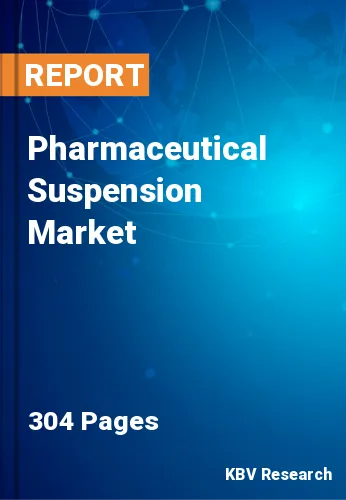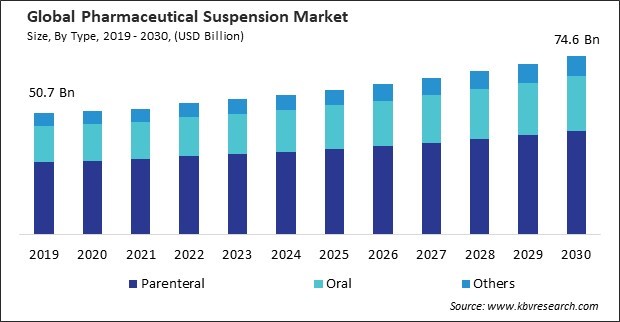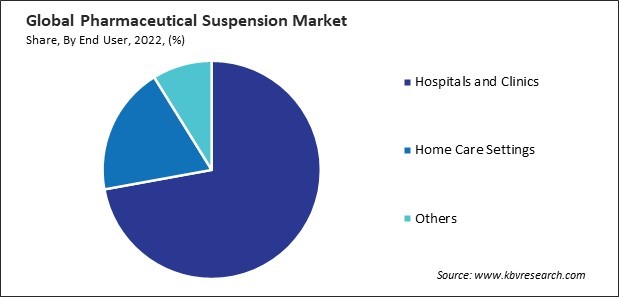
The Global Pharmaceutical Suspension Market size is expected to reach $74.6 billion by 2030, rising at a market growth of 4.0% CAGR during the forecast period.
Pharmaceutical suspensions can improve the bioavailability of drugs, especially those with low solubility. In the gastrointestinal segment, where absorption is critical, suspensions enable better drug dissolution, leading to increased absorption and enhanced therapeutic efficacy. Consequently, the gastrointestinal segment would generate approximately 13.76% share of the market by 2030. Gastrointestinal pharmaceutical suspensions can be formulated in various dosage forms, including liquids, powders, or effervescent formulations. This versatility allows for forming formulations tailored to patient preferences and specific therapeutic requirements, contributing to a diverse product portfolio.

Telemedicine enables healthcare professionals to manage and monitor patients’ medication regimens remotely. With their adaptability and ease of administration, pharmaceutical suspensions provide convenient options for patients who participate in telemedicine consultations and require remote medication management. Telemedicine services are often integrated with home medication delivery services. Therefore, the market is expanding significantly due to the expansion of telemedicine services. Moreover, Patient-centric healthcare emphasizes strategies to enhance medication adherence. With their palatable nature and ease of administration, pharmaceutical suspensions improve adherence as patients find these formulations more acceptable and easier to integrate into their daily routines. Patient education is a key component of patient-centric care. Thus, because of the increasing patient-centric healthcare trends, the market is anticipated to increase significantly
However, The development of new pharmaceutical suspensions often involves extensive research and development efforts. High R&D expenses, including costs related to formulation optimization, stability studies, and clinical trials, can strain the financial resources of pharmaceutical companies. Tailoring pharmaceutical suspensions to meet specific patient needs, such as personalized dosage strengths or flavors, can increase customization costs. Therefore, high-cost implications are a significant challenge that hampers the growth of market.
Furthermore, The movement of finished products and the accessibility of raw materials were adversely impacted by labor shortages, labor lockdowns, and restrictions on global travel, resulting in shortages and delays. The pandemic disrupted clinical trial activities across the pharmaceutical industry. Pharmaceutical suspensions, particularly those suitable for home administration, gained significance as healthcare providers sought patient-friendly dosage forms that can be easily administered outside traditional healthcare settings. Thus, the COVID-19 pandemic had a moderate effect on the market.
 Drivers
Drivers  Restraints
Restraints  Opportunities
Opportunities  Challenges
Challenges By type, the market is categorized into oral, parenteral, and others. The oral segment covered a considerable revenue share in the market in 2022. The oral segment is a key area for taste masking applications. Pharmaceutical suspensions allow for the addition of flavoring agents to mask the unpleasant taste of certain drugs. This is especially crucial in pediatrics, where taste can significantly impact medication adherence. By improving palatability, oral suspensions contribute to better patient acceptance. Oral pharmaceutical suspensions are used to develop extended-release formulations, providing controlled and sustained drug release. This is beneficial for chronic conditions that require continuous therapeutic effects and can reduce the frequency of administration.
By distribution channel, the market is segmented into hospital pharmacies, drug store & retail pharmacies, online providers. In 2022, the drug store & retail pharmacies segment registered the maximum revenue share in the market. Pharmaceutical suspensions, especially those formulated for common ailments and symptoms, are often available over the counter in drug stores and retail pharmacies. This accessibility encourages self-care and empowers consumers to manage minor health issues without a prescription. Drug stores and retail pharmacies stock various medications for various therapeutic areas. Pharmaceutical suspensions, adaptable to different conditions such as coughs, colds, allergies, and gastrointestinal issues, contribute to the comprehensive offerings in these establishments.
On the basis of end user, the market is divided into hospitals and clinics, home care settings, and others. The home care settings segment garnered a significant revenue share in the market in 2022. Pharmaceutical suspensions are typically liquid formulations, making them easy to administer, especially for patients with difficulty swallowing pills or capsules. In a home care setting, where self-administration or administration by family members is common, the liquid form of suspensions contributes to simplified and convenient dosing. Home care settings frequently involve managing chronic conditions requiring long-term medication. Pharmaceutical suspensions, particularly sustained-release formulations, offer a convenient option for patients to self-administer medications at home, reducing the need for frequent healthcare facility visits.

Based on indication, the market is classified into infectious diseases, cancer, gastrointestinal, neurological, and others. In 2022, the cancer segment witnessed the largest revenue share in the market. Cancer treatment often involves combination therapies using multiple drugs. Pharmaceutical suspensions enable the formulation of combination therapies in a single dosage form. This simplifies administration, improves patient adherence, and provides a comprehensive approach to cancer treatment. As new and innovative cancer therapies emerge, pharmaceutical suspensions provide a suitable platform for their development and delivery. This adaptability supports the growth of the market as it aligns with the evolving landscape of cancer treatment.
Free Valuable Insights: Global Pharmaceutical Suspension Market size to reach USD 74.6 Billion by 2030
Region-wise, the market is analysed across North America, Europe, Asia Pacific, and LAMEA. In 2022, the Asia Pacific region acquired a significant revenue share in the market. The Asia Pacific region’s growing population leads to increased healthcare needs. The Asia Pacific region has a significant proportion of pediatric and geriatric populations. The prevalence of chronic diseases, such as diabetes, cardiovascular conditions, and respiratory disorders, is on the rise in the Asia Pacific region. The Asia Pacific region is increasingly focusing on specialty medications and personalized treatments. The rise of home healthcare services in the Asia Pacific region creates a demand for pharmaceutical formulations suitable for self-administration.
| Report Attribute | Details |
|---|---|
| Market size value in 2022 | USD 55 Billion |
| Market size forecast in 2030 | USD 74.6 Billion |
| Base Year | 2022 |
| Historical Period | 2019 to 2021 |
| Forecast Period | 2023 to 2030 |
| Revenue Growth Rate | CAGR of 4.0% from 2023 to 2030 |
| Number of Pages | 304 |
| Number of Tables | 460 |
| Report coverage | Market Trends, Revenue Estimation and Forecast, Segmentation Analysis, Regional and Country Breakdown, Porter’s 5 Forces Analysis, Company Profiling, Companies Strategic Developments, SWOT Analysis, Winning Imperatives |
| Segments covered | Type, Indication, Distribution Channel, End User, Region |
| Country scope |
|
| Companies Included | Merck & Co., Inc., Bayer AG, Sanofi S.A., Pfizer, Inc., Novartis AG, AstraZeneca PLC, Glenmark Pharmaceuticals Limited, Teva Pharmaceutical Industries Ltd., Eli Lilly And Company, Lupin Limited |
By Type
By Distribution Channel
By End User
By Indication
By Geography
This Market size is expected to reach $74.6 billion by 2030.
Expansion of telemedicine services are driving the Market in coming years, however, High-cost implications of pharmaceutical suspensions restraints the growth of the Market.
Merck & Co., Inc., Bayer AG, Sanofi S.A., Pfizer, Inc., Novartis AG, AstraZeneca PLC, Glenmark Pharmaceuticals Limited, Teva Pharmaceutical Industries Ltd., Eli Lilly And Company, Lupin Limited
The expected CAGR of this Market is 4.0% from 2023 to 2030.
The Hospitals and Clinics segment is leading the Market by End User in 2022 there by, achieving a market value of $52.7 billion by 2030.
The North America region dominated the Market by Region in 2022 there by, achieving a market value of $25.8 billion by 2030, growing at a CAGR of 3.3 % during the forecast period.
Our team of dedicated experts can provide you with attractive expansion opportunities for your business.
